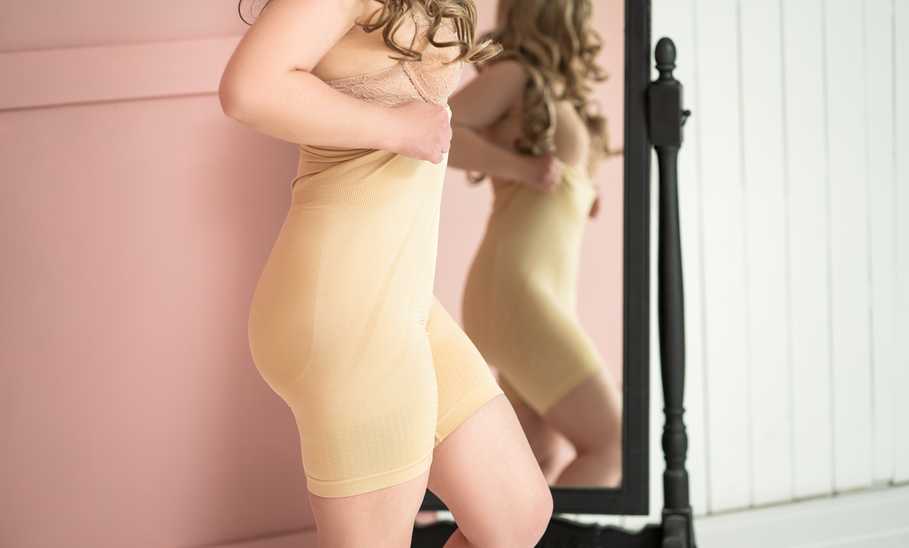What is Shapewear? Here’s What to Know Before You Shop

Our evaluations and opinions are not influenced by our advertising relationships, but we may earn a commission from our partners’ links. This content is created by TIME Stamped, under TIME’s direction and produced in accordance with TIME’s editorial guidelines and overseen by TIME’s editorial staff. Learn more about it.
As most people, and women especially know, foundation garments (or lack thereof) are an important component in how your clothing fits as well as how you feel about the way you look. Shapewear includes various styles that shape, sculpt, and, in some iterations, compress your body. If you’re new to shapewear, figuring out which best suits you can be overwhelming. There are a ton of choices, including bridal and wedding shapewear as well as everyday pieces like camisoles, shorts, and other tummy control options. Shapewear also typically comes in different levels of compression, support, and firmness.
On a basic level, shapewear is used to smooth out your silhouette under clothing. It is meant to enhance your natural shape, not change it. It also provides support for muscles and aids in promoting a better overall posture.
As well as working as a journalist, I have over 30 years of experience as a tailor and pattern maker for film, television, theater, and fashion. This means I’ve made garments, altered clothing, and conducted fittings with hundreds of people over the years. Many actresses (and some actors) I’ve worked with wear some kind of shapewear any time they’re on camera. While on the one hand, this points to the unhealthy demands and pressures many face to look a certain way and have a certain kind of body, shapewear can also help counteract some self-esteem issues by simply making you feel good about yourself and the way you look.
As Jane Newman, chief design officer of Global Innerwear, HanesBrands says, “There are a host of benefits to wearing shapewear, but the one our consumers lean into most is the boost in confidence they get from it.”
Maidenform’s shapewear portfolio, as well as that from other brands, includes “diverse, modern silhouettes and a range of control levels that make it simple to up your wardrobe game a notch,” Newman adds.
Whether you are looking for everyday pieces that offer lightly smoothing layers, or you’re headed to a special event and want more sculpted control, there’s a shapewear option to fit your needs.
While shapewear of the past tended to be made from unrelenting things like steel, whale boning, and thick, heavy, non-stretch canvas (corset, girdles, etc.), modern shapewear is constructed from breathable and stretchy materials that provide both comfort and flexibility.
“And,” says Cami Raymond, senior design director of Ruby Ribbon, the women's shapewear, intimates, and athleisure company, “it still offers shaping benefits.”
Most shapewear is fashioned from a combination of nylon, spandex, and cotton.
Nylon offers stretchability and durability, while spandex can conform to the body. Spandex comes in a range of thicknesses with varying levels of stretch and compression. Jumbo spandex, for instance, offers minimal give. It stretches, but its overall tendency is to revert back to its original state.
Spandex, also known as Lycra or elastane, refers to manufactured polyether-polyurea copolymer fabrics (meaning, not a natural fabric.) The base material of spandex, developed in the late 1930s in Germany, is polyurethane. The DuPont Corporation, which led the industry in synthetic fabric development at the time, used the basis for creating polyurethane to make a similar polymer fabric that also stretched. Polymers are made from repeating chains of monomers, which are bonded using an acid. Today, spandex fabrics are often combined with polyester and nylon.
Shapewear also often contains silicone, “especially in the waistbands or leg openings to prevent rolling or slipping,” says Raymond.
“Shapewear comes in varying levels of compression, ranging from light to extra firm,” says Raymond.
Light compression offers smoothing and slight shaping, while firm or extra-firm compression provides more significant shaping and support. Compression works by applying pressure to a targeted area (or areas) and redistributing flesh. It’s the same principle as using your hands to push your waistline in.
“Make sure to choose a compression level that provides the desired effect without sacrificing comfort,” says Raymond.
“Shaping panties are great for underneath pants, dresses, and skirts,” says Newman, “They provide cinched waistlines and tummy-smoothing control for everyday and special occasion wear.”
One great option is the Commando Classic Control Brief, which features light to medium compression and offers just the right amount of smoothing for everyday use.
Smoothing bodysuits can be worn as both underwear or outerwear (with jeans, etc.).
“They’re perfect for under dresses, or as a smoothing layer under coordinates,” says Newman. They offer a great, versatile, all-in-one item. “Plus,” she says, “they are having a major fashion moment right now.”
Check out the Spanx Invisible Shaping Mid-Thigh Bodysuit which has medium support with firm compression, and the Skims Fits Everybody High Neck Bodysuit which comes in colors like yellow and lavender, as well as skin tones.
“Waist cinchers nip the waist, making them great for special occasion outfits,” says Newman. They can even be used as a fashion item.
Reminiscent of corsets, waist cinchers often feature flexible boning and back hook-and-eye closures. The WaistHero Cincher by Honeylove offers adjustable levels of tightness depending on comfort and desired compression level.
“Camisoles and tanks are innerwear items that create a smooth silhouette under blouses and fitted tops,” explains Newman. You can wear them as an outerwear item.
Yummie makes a convertible shaping camisole with adjustable straps in a range of colors including red, blue, and peach.
“Smoothing and slimming shorts, including thigh slimmers and booty-lift shorts, are perfect for under slip dresses and skirts, as well as tight-fitting skirts, pants, and dresses,” says Newman.
Maidenform makes a great high-waist thigh slimmer as well as a booty lift short at an affordable price point.
“Shapewear isn’t one size fits all,” says Newman, “which is why Maidenform offers a variety of shapewear options from shaping briefs, thongs, and shorts to camisoles, body shapers, thigh slimmers, and waist cinchers.”
Wherever you buy your shapewear from, consult the company’s fit guide and read product descriptions. These will indicate the level of compression of the specific garment as well as information about how the fit will feel (restrictive versus not so restrictive). Try on various styles with differing support levels to determine what works best for you. If you want to learn more about shapewear for plus sizes, we have a guide on that.
If you are shopping for a specific occasion, make sure you try on the shapewear with the garment you intend to wear. When I’m making a custom dress for someone or a garment from another era, I always pattern, drape, and fit with the intended undergarments as they really do change the way something looks. For example, a dress made to be worn over a corset never fits correctly without that corset on.
Compression pantyhose (also called control top and support hose) and tights are also considered shapewear. There are even long sleeved shapewear bodysuits available like this one from Spanx.
I particularly love Wolford’s support tights and Commando Essential Sheer Control Tights.
“Control levels play an important role in picking the right shapewear for your needs,” says Newman.
Brands offer their shapewear in varying levels. For instance, Maidenform has three, called Smooths, Shapes, and Sculpts. Smooths provides an everyday, light control layer. Shapes is a firm foundation with more control for a sleek look, and Sculpts is the ultra-firm control that helps consumers enhance their curves. Spanx also labels its shapewear as smoothing, shaping, and sculpting.
Generally, you’ll find pieces in the following categories: light compression, medium compression, firm compression, and extra firm slimming. The stronger the compression, the more force will be exerted against your body and the less ‘give’ you’ll experience.
There are a few important things to consider with how shapewear should fit.
Raymond says to make sure you know your waist, hip, and bust measurements (as well as any other targeted area) as this will provide a baseline for determining your size. When looking at brands, refer to size charts and compare your measurements with it; that’s why they exist.
You should also consider compression level.
Ultimately, says Raymond, “focus on comfort, as shapewear shouldn't be painfully tight or restrictive. Ensure that it fits snugly without digging into your skin or causing discomfort.”
It should feel supportive and secure but not to the point where it affects your ability to breathe or move comfortably.
In a word, yes. If it doesn’t feel comfortable, something is amiss.
“You should feel comfortable in your shapewear,” says Newman. It’s especially important to purchase shapewear that isn’t too tight, as that could actually have a reverse effect on the look you’re trying to achieve, she explains. Look for something that holds you while not rolling, digging, or pinching anywhere.
Newman suggests starting with your normal size but also being open to experimenting with different shapes and silhouettes. This will help you find the perfect level of support and comfort that’s right for you. If you’re shopping in person, many sales associates at department stores (places like Neiman Marcus, Nordstrom, Macy’s, and Saks) with a lingerie/undergarment section can provide advice and recommendations. Bridal boutiques are also another great source.
Your specific shapewear needs depend on the type of clothing you’re wearing, says Raymond. Consider the length of your outfit, the neckline and whether or not there are any cutouts.
For example, if you’re wearing a dress, Raymond suggests opting for a seamless shaping bodysuit or shaping shorts.
“Or,” she says, “try combining two shapewear options for more casual outfits.” For example, she explains, pair a Ruby Ribbon Original Cami or Demiette with one of their shaping shorts as “a homemade body suit.” This will provide targeted compression in the midsection, hips, and thighs, which creates a smooth silhouette under fitted dresses.
She also recommends choosing skin-toned shapewear to minimize visibility under light-colored or sheer dresses, and looking for shapewear options with removable or adjustable straps to “adhere to your outfit.”
A quality shapewear bodysuit costs between $100 and $200, while shaping camisoles and shorts range from $12 to $75 a piece. As far as how much you should spend, remember that you’ll likely wear the perfect shapewear garment under multiple outfits.
A good foundation makes all the difference in the world, and paying for one that’s manufactured for durability and longevity is definitely worth it. This is my roundabout way of saying you get what you pay for, and well-made items fashioned from high-quality materials will cost more than those that aren’t. Unless you only intend to wear it once, you don’t want a garment that will lose its shape or stretch after one wearing and/or washing.
Most companies that manufacture shapewear have bridal and wedding collections. These pieces feature specialty necklines to accommodate formal and wedding dress styles such as plunge, low back, low back, open bust, and various panties and shorts.
Compression socks, made to gently squeeze your legs and promote circulation, are also a form of shapewear. They are useful during long-haul plane rides or for people recovering from an operation.
When my appendix ruptured a couple decades ago and I was consequently hospitalized for a week, they gave me compression socks to help keep my blood flowing to my legs while bedridden. Medical compression garments extend past socks and may be prescribed by doctors to help with a variety of vascular conditions.
Shapewear does not permanently alter your body. Once you remove it, everything moves back to its original state. In the past, people—most commonly women—have been subjected to techniques and devices that have shaped and altered their bodies. Things such as the rather disturbing practice of foot binding wherein young girls’ toes were intentionally broken, then bound to prohibit proper healing and growth. This would result in what was considered a desirable foot size: three inches or the ‘golden lotus.’
During Victorian and other corset-wearing eras, studies show that long-term corset use altered the skeletons of those who wore them. During these times, girls would be corseted from a young age. Today, some people turn to waist trainers to reform their silhouettes. Generally, waist trainers (which are not considered to be shapewear) produce more negative than positive effects—things like breathing and digestive issues, rashes, and overall weakening of your internal organs. They can also cause reduced core strength. Instead, if you’d like additional shaping in this area, the safest option is tummy control shapewear.
![[object Object] [object Object]](https://spanx.com/cdn/shop/products/71d014679af2f771f1dda9a0c6bef92ddbee8365_794x.jpg?v=1675876144)
As pointed out above, always remember that shapewear is not the magical answer to a completely different body shape than the one you already have. Shapewear is meant to enhance you and your curves, not force your body into a different size.
As Newman explains, “Shapewear allows you to feel supported all day long. It enables the wearer to define, smooth, shape, and enhance their look depending on their choice of apparel.” It should make you feel good; not restricted or confined.
“As a consumer in this space,” says Newman, “the most important thing to consider when shopping for shapewear is to think through what type of shaping, smoothing, or cinching you are hoping to achieve.” This will allow you to easily navigate the selection of products and find what you’re looking for.
Wearing shapewear does indeed flatten your stomach and a high level of compression can take from 1 to 2 inches off your measured waistline. But again, as soon as you take it off, everything reverts. Shapewear will not help you lose weight nor physically alter your body.
The information presented here is created by TIME Stamped and overseen by TIME editorial staff. To learn more, see our About Us page.



